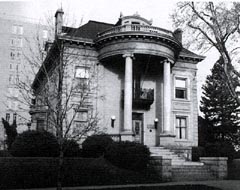The 6th and 7th blocks of Logan to Steele
From Steele to Colorado Blvd only the houses ON the parkway are included in the district.
All of the 600 block between Harrison and Colorado Blvd is also included.
(This was done in order to connect the 7th avenue parkway to the 6th avenue parkway)
|
From containing the residence of the Summer White House during the Eisenhower administration to being home of the inventor of the ice cream soda, the East 7th Avenue Historic District is one of the most interesting and beautiful in Denver. Primarily built from the 1890’s to the 1930’s, the East 7th Avenue Historic District is the largest in Denver with its boundaries stretching from Logan Street to Colorado Avenue, and from 6th Avenue to 8th Avenue. Between Steele and Harrison Streets, the district is limited to the 7th Avenue Parkway. Because Downing Street was a main thoroughfare in the late 1890’s, the earliest construction in the district is found nearby on the 700 Blocks of Corona and Marion. 7th and Williams Street contained a stable for horses that used the Cheesman Esplanade, or “Little Cheesman”, for their exercising. Additionally, the 700 Blocks of Franklin and Gilpin housed early greenhouse businesses that flourished as development began on the barren prairie land. The parkway itself was created in 1912 and rose from the peak of the City Beautiful movement. Mayor Speer hired well-known landscape architect Saco DeBoer to plan the plantings for many of the parks and parkways in the city. Charles Mulford Robinson, a city planner, and George Kissler, a Kansas City landscape architect, consulted with Frederick Law Olmstead, creator of New York’s Central Park, to construct plans for an entire system of city parks and parkways. Upon completion, by way of the East 7th Avenue Parkway, Cheesman Esplanade, and Williams Street Parkway one could travel all the way from City Park to Washington Park! Early residents of the 7th Avenue Historic District were a mix of both wealthy and middle class citizens. As development continued, larger mansions were built on corners and facing the parkway while more modest homes, including duplexes and flats, were built to the north and south. William E. Fisher and Glen Wood Huntington designed many of the residences within the district. Pre-WWI construction styles were primarily Mediterranean Revival, Neoclassical, and Colonial Revival, though the district is home to quite a variety of architectural styles that lend to its unique character. The Governor’s Mansion, at 8th and Logan, is housed within the 7th Avenue Historic District, and was planned by Walter Scott Cheesman. Later purchased by the Boettcher family, the residence was donated to the state for the Governor’s Mansion in the late 1950’s. 750 Lafayette was the childhood home of Mamie Doud (Eisenhower), and was the location of the Eisenhower’s wedding as well as the working White House in the summers during his time in office. 2700 East 7th Avenue was first owned by Marie Baur, the widow of Otto Baur, who came up with the idea for the ice cream soda! Today the East 7th Avenue Historic District retains much of its original character and charm and continues to thrive as one of the most desirable neighborhoods in the city.
|
| Landmarks | |
 |
ZANG MANSION 709 Clarkson St.Sedate Neoclassical Revival mansion designed by Frederick C. Eberley in 1903 for Adolph J. Zang, son of Zang Brewery founder. Interior boasts gilded ceilings, five fireplaces, Tiffany chandeliers, handcarved woodwork and stained-glass window scene from Shakespeare’s Merchant of Venice. |
7th Avenue Neighborhood Association
Neighborhood Boundaries:


